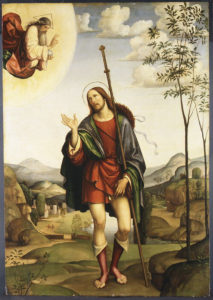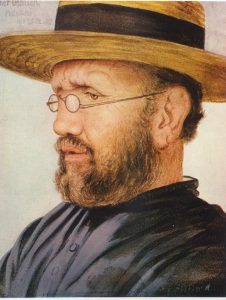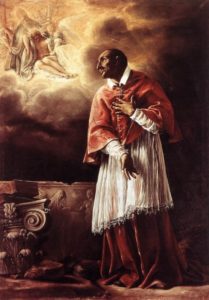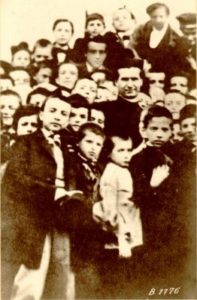Just a century ago, plague was common. Smallpox, malaria, measles, whooping cough, polio, plagues raged, they ravaged, they subsided. Plagues came in waves, years or even decades apart. We all remember learning of the Black Death in 1348, but that was merely the worst wave, the largest tsunami in the constant ebb and flow of the oceans of plagues that surged about an afflicted mankind. Famine punctuated the plague waves, acting in concert with them. Famine weakened the immune systems of those who survived the last plague, plague killed the workers who might have otherwise been able to farm and harvest enough crops to avert the next famine.
Together, famine and plague led to war, as neighboring countries desperately tried to grab enough resources between plagues and famines to survive the next wave of famine and plague. And war led large groups of sick, weak, ill-fed troops to gather tightly together, each spreading their own illness to the others, as the troops and their camp followers tried to wage it. It is often forgotten that World War I was was the very first big war in history in which more were killed by military action than by infectious diseases (and even that is arguable, since the Spanish Flu killed five times more people than World War I did). War brought violent death, but it wrought more death by famine and disease than it ever did by sword or spear.
We are shocked by famines and epidemics because we really don’t have them anymore. But epidemics, famine and war wrought suffering, and out of that suffering came saints. We have been so shocked by this latest plague that we have forgotten how the saints handled plague. But we are slowly remembering.
 St. Roch (d. 1327) lived through plague years. He was said to have cured plague victims he visited in Italy with his prayers and by marking the sick with the sign of the cross. St. Roch saw in the plague-stricken an image of the Savior stricken with suffering for the sins of us all. However, when he, too, was sickened by the plague, he withdrew to a hut in the forest until he recovered. He did not know germ theory, but he knew enough to respect the illness, and the possibility that he might transmit it to others. When stricken with plague, he isolated himself, lest he injure others.
St. Roch (d. 1327) lived through plague years. He was said to have cured plague victims he visited in Italy with his prayers and by marking the sick with the sign of the cross. St. Roch saw in the plague-stricken an image of the Savior stricken with suffering for the sins of us all. However, when he, too, was sickened by the plague, he withdrew to a hut in the forest until he recovered. He did not know germ theory, but he knew enough to respect the illness, and the possibility that he might transmit it to others. When stricken with plague, he isolated himself, lest he injure others.
 Damien of Molokai (d. 1889) chose to personally enter a Hawaiian leper colony in order to minister to the victims, but he didn’t bring others with him, nor did he endanger others. In fact, when he needed to make confession, he was willing to shout out his sins to the priest on board a coastal ship, so that all the shipboard crew could hear, rather than come aboard and risk infecting others.
Damien of Molokai (d. 1889) chose to personally enter a Hawaiian leper colony in order to minister to the victims, but he didn’t bring others with him, nor did he endanger others. In fact, when he needed to make confession, he was willing to shout out his sins to the priest on board a coastal ship, so that all the shipboard crew could hear, rather than come aboard and risk infecting others.
 Charles Borromeo (d. 1548), like St. Roch, knew nothing about germ theory, yet he ministered to the sick during the 1576 outbreak of bubonic plague in his city. He was sure the plague was God’s wrath poured out on the city, a wrath that only spiritual humility and abasement would end. Even so, while he led processions of the faithful to receive ashes on their foreheads, he also ordered them to stay at least a stick’s length apart while in procession. He closed all the churches, but erected crosses in the piazzas so that those under quarantine could join in prayer from their windows. If plague were purely an example of God’s wrath, then why engage in social distancing? Why close the churches? Indeed, why would a stick’s length distance between sinners avert the wrath of God Himself? Yet he enforced precisely this social distancing on, and allowed quarantining of, the Catholics under his care.
Charles Borromeo (d. 1548), like St. Roch, knew nothing about germ theory, yet he ministered to the sick during the 1576 outbreak of bubonic plague in his city. He was sure the plague was God’s wrath poured out on the city, a wrath that only spiritual humility and abasement would end. Even so, while he led processions of the faithful to receive ashes on their foreheads, he also ordered them to stay at least a stick’s length apart while in procession. He closed all the churches, but erected crosses in the piazzas so that those under quarantine could join in prayer from their windows. If plague were purely an example of God’s wrath, then why engage in social distancing? Why close the churches? Indeed, why would a stick’s length distance between sinners avert the wrath of God Himself? Yet he enforced precisely this social distancing on, and allowed quarantining of, the Catholics under his care.
Despite this precautions, and the fact that he spent all of his family’s enormous wealth on the care of the sick, the good saint’s insistence on gatherings large groups of people together for spiritual ministration were not very effective in “appeasing God’s wrath”, for Milan lost about one-third of its population, which is about the same as the rest of the European cities struck by plague at that time. That is, if the plague were a physical manifestation of the outpouring of God’s wrath, then his processions to appease that physical wrath were not very effective.
 St. John Bosco (d 1888), on the other hand, lived at a time when germ theory was finally being understood. He organized his students to help during a cholera epidemic, but he ordered them to wear face masks at all times and wash their hands with vinegar after ministering to cholera victims. If they ran out of vinegar, they were to come straight back to the oratory without talking to or in any way interacting with anyone. That is, Don Bosco enforced the same social distancing his forebears had, but he was able to employ a much better form of PPE.
St. John Bosco (d 1888), on the other hand, lived at a time when germ theory was finally being understood. He organized his students to help during a cholera epidemic, but he ordered them to wear face masks at all times and wash their hands with vinegar after ministering to cholera victims. If they ran out of vinegar, they were to come straight back to the oratory without talking to or in any way interacting with anyone. That is, Don Bosco enforced the same social distancing his forebears had, but he was able to employ a much better form of PPE.
Don Bosco lost none of his boys to cholera. Don Bosco had a lot better luck appeasing God’s wrath with his face masks, vinegar bottles and social isolation than our sainted friend Borromeo had with his constant processions. That either means Don Bosco was holier than Borremeo, or that God’s wrath is better appeased by correctly using the tools and the reason God gave us. Perhaps God favors the people who understand and respect how to deal with His creation, the viruses and bacteria. Perhaps all of the above.
Remember, processions didn’t save Milan from the plague.
Vinegar and face masks DID save Bosco’s boys from the plague.
So, take some lessons from the lives of the saints who fought plagues:
- Engage in social distancing, as all the plague saints did.
- Wash your hands and wear face masks, as Bosco’s boys did.
- Quarantine yourself, as all the saints encouraged plague victims to do.
- Remember that Bosco’s mother stripped the altar of its linens to care for the sick, and
- St. Charles Borromeo closed the churches during plague years, just as today’s bishops have done.
Show a healthy understanding and respect for God’s creation, right down to the bacteria and the viruses, as the bishops do. As Eastertide approaches, do not murmur and grumble against your spiritual leaders, as the followers of Korah did against Moses, as the bishops’ detractors do today. For the followers of Korah thought themselves chosen by the Lord, but even in the midst of their holy prayers, God caused the earth to swallow them alive, and those who whined and grumbled against Moses’ leadership were struck down by the plague that followed.
___
Originally published at The Fifth Column.







1 thought on “Saints vs the Plague”
St Charles Borremo failed because he closed the Churches. Did not offer proper Mass to the laity. The restrictions such as wearing masks and isolating ourselves is Demonic.